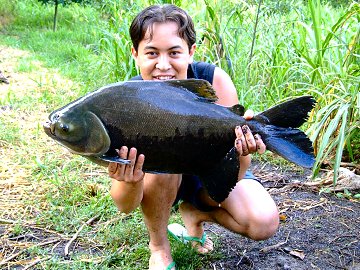 |
| Tambaqui (Colossoma macropomum) |
There is an amazing abundance and variety of fish in the Upper Amazon. For both mestizo and indigenous peoples, the lakes and rivers are an endless source of food, with more than two thousand species of freshwater fish. There are catfish of all sorts — the boquichico (Prochilodus nigricans), carachama (Pterygoplichthys multiradiatus), doncella (Pseudoplatystoma tigrinum), and especially the delicious dorado (Brachyplatystoma flavicans), which can grow to a hundred pounds in deep river channels and oxbow lakes. There are carahuasú (Astronotus ocellatus), paña, piranha (Pygocentrus nattereri), tambaqui (Colossoma macropomum), sábalo (Brycon melanopoterus), and paiche (Arapaima gigas), the largest freshwater fish in the world, whose flaky and delicately flavored flesh has been featured in Gourmet Magazine.
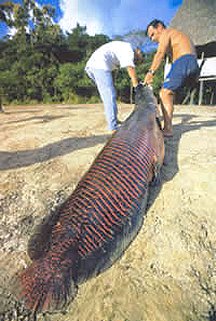 |
| Paiche (Arapaima gigas) |
Machiguenga greet strangers by asking, “Are there fish in the river where you live?” La Patarashca, a restaurant in Tarapoto, serves doncella stuffed with shrimp in a sauce of cocona fruit (Solanum sessiliflorum), and as a patarashca — stuffed leaves — with tomato, onion, and sweet chili, wrapped in bijao leaves (Calathea lutea). People are not fooling around here.
But first you have to catch the fish.There are a number of places in the Upper Amazon which are particularly good for finding fish. Large and medium-sized rivers in low areas often form numerous meanders which, when the river changes course, become cochas, oxbow lakes. These cochas often have sediment settled on the bottom, relatively clear water, and high temperatures, and therefore rapid plant growth, which in turn supports quite large fish populations. Sometimes too you can see strips of clear and very slow water in a river. These are quiet places where plankton tends to grow; you can usually find fish downstream. You can also find fish under camalones, places where aquatic vegetation has formed a dense mat on the surface of the water. And fish love to move into the waters covering seasonally flooded forests.
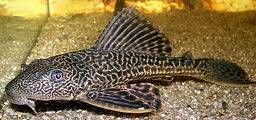 |
| Carachama, sailfin catfish (Pterygoplichthys multiradiatus) |
It is possible to take fish just with your hands. It is not as hard as it sounds; I once caught a beautiful trout with my bare hands in a stream in the Esacalante Wilderness. In the Amazon, people wade close to shore in muddy water, gently feeling for fish under rocks and in the mud. In particular, carachama, the armored sailfin catfish (Pterygoplichthys multiradiatus), constructs burrows in the muddy banks of the cochas and rivers in which it lives, each a few feet deep and generally angled downward. You only need to feel around for a burrow, reach in, and very carefully — because carachama have very sharp spines on their dorsal fins — pull a carachama out of its hole and toss it up onto the bank. They are delicious.
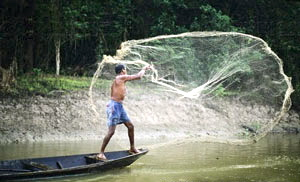 |
| Net casting |
People in the Amazon often fish with hook and line — an innovation dependent on the availability of steel hooks and high test monofilament fishing line. All you have to do is tie a hook to a length of line on the end of a stick, put a piece of grasshopper on the hook, and toss the hook into the water. Especially in an overpopulated cocha, in just a few minutes you have caught a fish. You can do this over and over again; in half an hour, you have caught enough fish for several days. You can be creative, and tie a piece of wood to the string as a float. If you have a family to feed, you can set out a trotline with baited hooks. Hook-and-line fishing can be done where other methods do not work — at night; during the rainy season, when the water is turbid; in the main current of the river. And it is considered to be — heck, it is — fun.
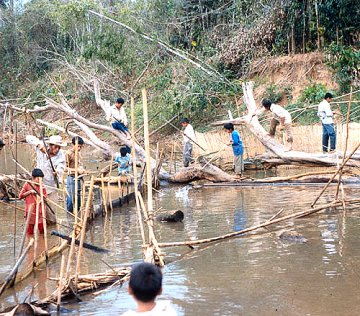 |
| Communal fishing with barbasco (Lonchocarpus urucu) |
Fishing nets can be cast from a canoe or by wading out into the water. Casting a fishnet requires skill clearly beyond my own, although, to my chagrin, I have seen numerous young boys do it quite successfully.People also fish using fish spears or bows and arrows — usually with barbed two-tined heads — either from a canoe or from shore, sometimes on the river right in frront of the village. Spear and bow-and-arrow fishing is largely limited to the dry season, when rivers tend to be clear rather than silty. A fisher can also put a tabaje, a fish trap, across a cocha outflow. Tabajes are woven from strips of caña brava, giant cane (Gynerium sagittatum) or bombonaje (Carludovica palmata). I have seen two mestizo fishermen work a running stream by anchoring a woven barricade with sticks downstream, driving fish into the trap from upstream, and then gathering them by hand. In a few hours they had caught enough fish, after being dried and salted, to last for a week.
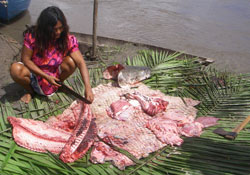 |
| Preparing fish for salting and drying |
Fish poison is also widely used in the Upper Amazon. The term barbasco can be used to refer to fish poison in general, or more specifically to Lonchocarpus urucu, which is of sufficient importance that some indigenous peoples cultivate it in their gardens. The procedure is simple: the root is is dug up, carried to the fishing place, and pounded with sticks so that the milky sap can be drained into the water. The primary active ingredients are rotenone and deguelin, which affect gill function in fish, inhibiting their ability to breathe. Within fifteen minutes or so fish begin to float on the surface of the water, where they can be collected by hand or in baskets, hit on the head with a machete, speared, or shot with a bow and arrow.Fishing with barbasco in a cocha is simple; squeeze the milky sap into the still water, watch it spread, and then collect the fish. It only takes one or two people to fish a cocha in this way. On the other hand, in a flowing stream or river, you have to build a dam at the upper end of the fishing area to slow the flow, and another at the lower end — sometimes with a woven basketry net — to make it easier to capture the stunned fish. Such temporary dam construction may require additional people, which can, of course, turn into a party.

- Previous Post: Animated Shamanism
- Next Post: More Legal Stuff
- More Articles Related to: Indigenous Culture, Jungle Survival, The Amazon



do people in the upper amazon need any modernity, any access to “civilization”?
I don’t think so!
I am concerned about the use of "Lonchocarpus urucu Killip & A. C. Smith" (Barbasco) due to the Rotenone. Is there a high insidence of Parkinson's Disease in those areas? One would think that after years of ingestion, there may be. However, perhaps the drying of the fish inactivates the Rotenone (where it degrades naturally within two weeks with exposure to light). Any knowledge to this regard? I'm planning my eco-trip there. Thanks.